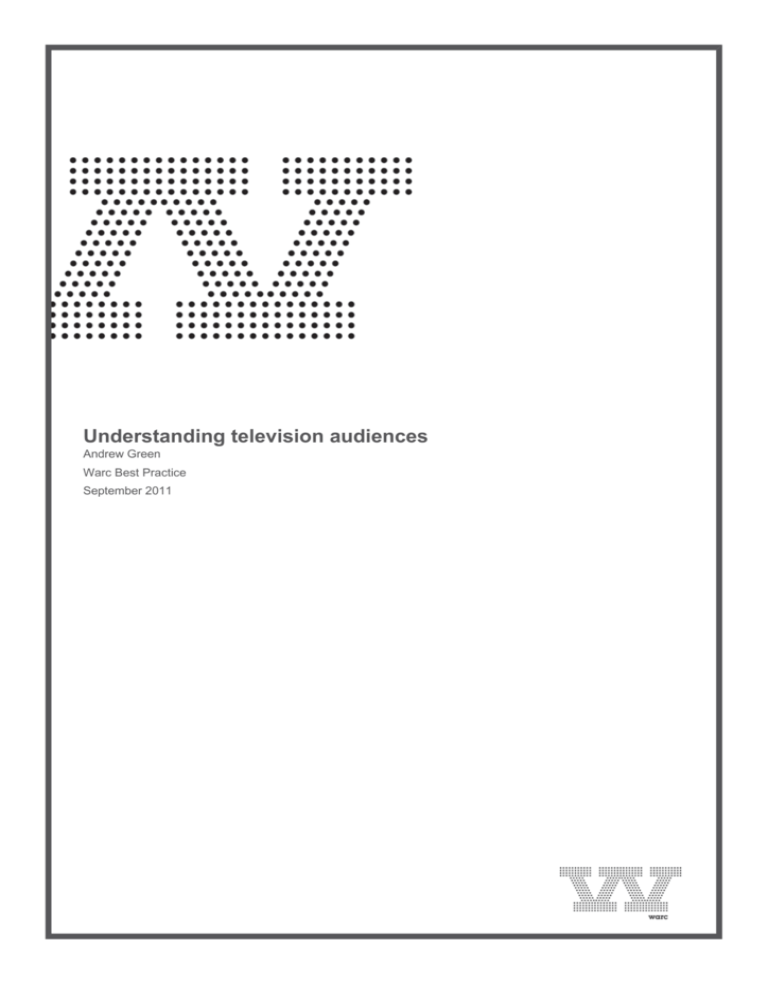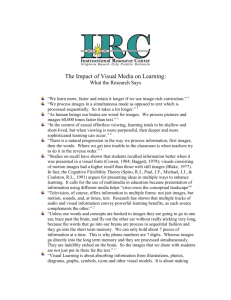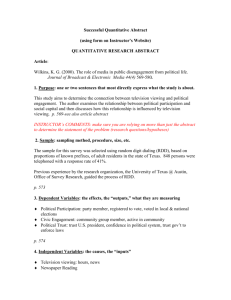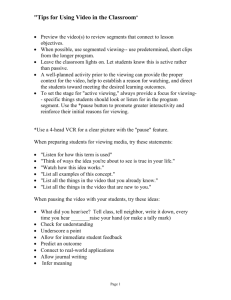
Understanding television audiences
Andrew Green
Warc Best Practice
September 2011
Title:
Author(s):
Source:
Issue:
Understanding television audiences
Andrew Green
Warc Best Practice
September 2011
Understanding Television Audiences
Andrew Green
Ipsos MediaCT
Go to: EXECUTIVE SUMMARY
Go to: ESSENTIALS
Go to: WHERE TO START
Go to: FUTURE DEVELOPMENTS
Go to: CONCLUSION & CHECKLIST
Go to: FURTHER READING
EXECUTIVE SUMMARY
According to ZenithOptimedia's July 2011 advertising expenditure forecasts1, television is the dominant mass medium in the
minds of major marketers and consumers. More than $189 billion will be spent on TV advertising in 2011, representing a 41%
share of major media adspend globally. Ten years ago, in 2001 – with internet advertising still in its infancy – the medium's
share stood at 38%.
Television therefore remains, for many marketers, the primary communications channel when launching a new brand or
supporting an existing one. It offers impact through sound, pictures and motion, the ability to reach lots of people quickly, and
'talkability'.
This talkability, often referred to as the 'water cooler' effect (the water cooler being, legend has it, where people would stand
around discussing the previous night's television programmes) has been enhanced by the growth of on-line social media
outlets such as Twitter and Facebook.
Downloaded from warc.com
2
ESSENTIALS: The Power of Television Advertising
Television plays to many strengths as an advertising medium. These include:
l
Impact through audio-visual images and movement
l
High and fast-building coverage of all target groups
l
Traditional competitive battlefield for brands
l
Talkability
l
Interactivity
WHERE TO START: Measuring television audiences
Research into the television audience includes measurement of:
l
Audience size, composition, flow and duration
l
Audience interaction – how viewers react to programmes and advertising (e.g. fast forwarding of programmes played
back on DVRs and ad avoidance)
l
The impact of programme and advertising context on receptivity to advertising
l
Talkability – the extent and duration of viewers' on- and off-line conversations during and after a programme or ad has
aired
TV audience measurement (TAM)
Since the early 1990s, most television markets have been measured electronically using people meters, which replaced the
earlier system of paper diaries. By mid-2011, around 75 countries worldwide used electronic measurement of one sort or
another.
Peoplemeters are household-based devices, automatically detecting whether sets are on or off and identifying the channels to
which they are tuned. People in sample households press buttons to indicate when they are present in a room with the set on.
As measurement devices, they suffer from several key weaknesses:
l
They cannot account for viewing that takes place out of the home
l
They indicate the presence of a viewer, but not his or her attention to the screen
l
Meters will not accurately represent the viewing of those who fail to press their buttons2
The first and last of these have prompted much work into devices that attempt to measure individual (rather than household)
viewing with minimal intervention from the respondent.
The Portable People Meter (PPM) was developed in the early 1990s and first tested by Arbitron as a radio measurement
device in Manchester (UK) in 1998 and then in Philadelphia in the United States shortly afterwards3.
It is based on embedding an inaudible code into the audio part of a broadcast stream. This is then detected by a panel of
people carrying special pager-like devices whenever they are within earshot of the signal. PPMs were first used to track
Downloaded from warc.com
3
television audiences in 2003 in the Canadian province of Quebec4,5.
Respondents do not have to remember to press buttons when they enter and leave a room and, of course, exposure outside
the home can be picked up. A disadvantage is that 'presence in the vicinity of an audio signal' (the PPM definition of a viewer)
is not the same thing as actually watching television. Another is that many people may not want to carry a pager device with
them all the time.
Arguably, of course, the basic peoplemeter definition of viewing ('people in a room with a TV set on', supplemented in some
markets with 'and watching') may not accurately represent the number of people actually watching either. But the link between
attentive viewing and measured exposure to an audio signal is likely to be weaker outside the home than it is inside, with
viewers possibly just passing by locations that happen to have televisions switched on.
A challenge for the PPM has been to ensure that respondents actually carry their devices with them throughout the day and
that they do so consistently and continuously. Newer devices such as Ipsos's MediaCell, also based on the idea of capturing
exposure to encoded audio signals, have addressed the challenge of asking people to carry an extra device by simply
uploading special software into the Smartphones of a panel of people. They are asked to keep these switched on and with
them throughout the day – which, in the majority of cases, is what they do anyway.
The audience results generated by traditional Peoplemeters and newer passive devices vary – often considerably. The
problem then becomes to decide which of them is closer to the 'truth' or, more realistically, is commercially acceptable to all
sides of the buying and selling equation.
Set-top boxes
Another development in TAM is the use of set-top boxes to gather more detailed television tuning data. An increasing limitation
of sample-based TV audience measurement (such as both people meter and PPM panels) is the growing fragmentation of
audiences6.
In the US, for example, the average household receives well over 100 channels. In the UK, as Shabbab pointed out as long
ago as January 2005, of 166 channels measured by BARB, only 14 achieved an audience share exceeding 1%. Since then,
more channels have been launched.
Set top box panels consist of large numbers of digital cable or satellite subscribers who agree to have their set top boxes
tracked, with every set tuning action recorded – such as switching on or off, changing channel etc. Samples can run to several
hundred thousand households7. Viewing data can be examined right down to the second-by-second level with robust data for
almost any sized channel or programme.
The drawback of these panels is that set-top boxes only measure the status of the television set (and may not be connected to
all the sets in a household). We cannot be certain that anybody is actually watching (or, if they are watching, who is in the
room) or even, in some cases, whether the box has simply been left on standby.
One possible solution is to model individuals' viewing from large household panels8. This may become more popular as some
of the large digital subscriber household panels around the world take root.
Downloaded from warc.com
4
The viewing context
The context in which an ad is viewed (both the programme and the advertising surrounding the ad) is likely to influence the
response to the message9.
This can refer to a viewer's physical surroundings (are they watching at home or somewhere else?), the social environment
(watching alone or with others) or other factors that might affect their attentiveness, such as interest in the product category
being advertised, the time of day, the day of the week or the mood they are in.
A debate raged amongst academics in the 1980s between those who believed that high or low attention to programmes
carried over directly to commercials and those who believed the opposite: that people paying high attention to a programme
would have a negative reaction to commercials interrupting their viewing. The first view generally attracted more support than
the second.
Much work has been done over the years by media agencies and television stations on the subject of programme involvement
and its relationship to commercial recall10. A popular measure of likely engagement with a programme has been to look at
viewer loyalty to particular shows (e.g. whether people watch every episode of a series or programme or just tune in
occasionally) and how much of a broadcast they actually stay tuned for (for example, do they watch all of it, or only part?)
Syndicated services like IAG evaluate programmes according to their level of viewer appeal or engagement in the United
States; in the case of this company, hundreds of thousands of viewers are polled daily and asked to answer a series of trivia
questions about programmes they claim to have watched the previous day. The number of these questions that are correctly
answered indicates how 'engaged' the viewers were – with a similar exercise undertaken for commercials.
Probing more deeply
It is now possible to monitor audience behaviour in considerable detail, using data from set-top boxes or personal video
recorders. The latter have given viewers much more control over what they watch. Programmes are recorded onto a hard
drive with a simple click and then played back later – with commercials often fast-forwarded over.
Work by TiVo in the US television environment of the 1990s suggested that commercials were likely to be fast-forwarded in the
programmes people liked most – because it was these programmes that tended to be recorded for later playback in the first
place.
In a study of prime-time programmes there, around two-thirds of prime-time shows were watched in playback mode. The
average commercial break was skipped in 54% of cases, and avoidance was particularly marked in the most highly involving
programmes11.
This work was based on early adopters to the personal video recorder, a technology now present in a far greater number of
households. Arguably, the increasing ease with which viewers can flip between what they want to watch and what they don't
using PVRs and other emerging technologies may mean that all viewing will, by definition, be attentive viewing. After all, if
people don't like what they are watching, they will simply switch to something else or fast-forward.
Interactive TV
Downloaded from warc.com
5
Little has been written to date on interactive television, which remains at an early stage in its evolution. But it offers up the
potential for viewers to play along with game shows, vote in live polls, get statistics on sports players and, of course, to
research and buy things by pushing a button on their remote control devices12.
It also takes us to the questions raised back in the 1980s about the relationship between programme attention and
involvement on the one hand and advertising receptivity. Early, experimental data suggests that viewers are more likely to
interact with ads in programmes they have less interest in, which adds to the story being told by early PVR users – that
programmes people particularly like may not be the best places to place advertising13.
FUTURE DEVELOPMENTS: Towards Perfect Television Measurement
Passive audience measurement faces a number of barriers to adoption – for television as it does for radio. The first is cost –
although this is less of an issue for television, which has a far greater share of advertising dollars than radio.
The second is fear of change – nobody likes to alter an existing audience measurement approach, especially if there is any
danger it will show lower audiences for some or all of the channels paying for the study.
The PPM and MediaCell approaches demand that TV stations embed special codes into their broadcast stream – which they
may refuse to do. So station co-operation is vital to paint a complete picture of the audience.
Perhaps most important of all, the very definition of viewing is different with passive, electronic measurement. Instead of
relying on people pushing buttons to indicate presence in a room with a television set switched on, the new approaches simply
measures their presence in the vicinity of an audio signal, with no information on how intently – if at all – they might be viewing
the associated television broadcast.
But passive measurement offers advantages too:
l
Continuous viewing data over long periods for very low incremental cost
l
Possible combination with set-top box 'census' data
l
All viewing occasions measured, however brief
l
Low dropout, due to low respondent burden
l
Ability to measure radio and other audio-based media
l
Potential for further Smartphone applications to be integrated with the TV tracking
The whole area of interactive television is being transformed by direct linkage of television sets to the internet, meaning that
viewers can watch television and surf the net on the same device at the same time, possibly minimising the television picture
at certain points. This will be something audience measurement will have to capture and help to assess.
CONCLUSION & CHECKLIST
Most other media define themselves and their research objectives in relation to television. Numerous studies funded by radio,
print or Out of Home industry bodies focus on how these media can compete with or add value to a television campaign.
Downloaded from warc.com
6
The internet has been making giant strides against other media over the past ten years or so – but television's share, overall,
is even higher than it was ten years ago. So the medium is healthy, but this does not mean it can stand still.
Over the next few years the industry's key challenges will be to:
l
Adopt electronic measurement to overcome weaknesses in peoplemeters
l
Gain greater understanding of audience engagement with ads in PVR-recorded content
l
Measure audience interaction with online content via their television sets
FURTHER READING
Articles on warc.com
The March to Reliable Metrics: A Half-Century of Coming Closer to the Truth
Edith G. Smit and Peter C. Neijens, Journal of Advertising Research, Vol. 51, No. 1, 2011, 50th Anniversary Supplement,
pp. 124-135
From Prime Time to My Time - Measuring television audiences
Andrew Green, Warc Exclusive, From Prime Time to My Time, 2010, pp. 82-124
The Future Arrived Yesterday
Nigel Walley, Warc Exclusive, MRG conference, November 2010
A serious examination of the myth of TV viewing
Tim Jones and Tom Baxter, Market Leader, Quarter 1, 2010, pp. 26-29
Empirical Evidence of TV Advertising Effectiveness
Joel Rubinson, Journal of Advertising Research, Vol. 49, No. 2, June 2009, pp. 220-226
Books
Green, Andrew (2009). From Primetime to My Time: Audience Measurement in the Digital Age (Warc)
Belville, Hugh (1985). Audience Ratings. Radio, Television, Cable. (Lawrence Erlbaum Associates)
Websites
www.thinkbox.tv
www.slideshare.net/joelrubinson/tv-effectiveness-webcast-rubinson
www.tvb.ca (PDF)
FOOTNOTES & REFERENCES
1. www.zenithoptimedia.com – Adspend forecasts July 2011
2. Kasari, Heikki J. (2006): Peoplemeter systems in the changing TV climate. Admap, October 2006.
3. Patchen, Robert and Webb, Beth (2003). A Full Year of Audience Research with PPM. ESOMAR Radio Audience
Measurement Conference, June 2003
Downloaded from warc.com
7
4. Pellegrini, Pasquale and Purdye, Ken (2004). Passive versus button pushing. A comprehensive comparison from parallel
TV meter panels in Quebec. ESOMAR Television Audience Conference, Geneva, June 2004.
5. Patchen, Robert H. and Webb, Beth (2005). New Insights on first-time electronic data on out-of-home and time-shifted
television viewing. ESOMAR TV Conference. Montreal, June 2005.
6. Doe, Pete (2003). Understanding zero ratings. Admap, December 2003.
7. Shabbab, George and Marks, Richard (2010). Horses for Courses - RPD or Peoplemeter? Five years on from Montreal
WAM. ESOMAR TV Conference, Berlin, October 2010.
8. Gray, Stu and Ephron, Erwin (2001) Why we can’t afford to measure viewers. Journal of Advertising Research, 41, 1,
2001.
9. Green, Andrew (2006) What is the impact of the commercial break environment on receptivity to my advertising? Warc
Media FAQs, January 2006.
10. Nazaroff, Annette and Byfield, Sheila (2003). Purple GRPs. ESOMAR TV Audience Measurement Conference, Los
Angeles, June 2003
11. Green, Andrew (2007). Do people fast-forward TV advertising when they can? Warc Media FAQs, January 2007.
12. Gritten, Adele (2006) The future of TV advertising – is it all over? Not half! Admap, September 2006.
13. Levy, Shalom and Nebenzahl, Israel D. (2006) Programme involvement and interactive behaviour in interactive television.
International Journal of Advertising, Vol. 25, 3, 2006.
ABOUT THE AUTHOR
Andrew Green is Chief Marketing Officer at Ipsos MediaCT and the author of the book, From Prime to My Time: Audience
Measurement in the Digital Age. He has held senior research positions at Zenith Optimedia, Billetts, OMD, Nielsen and Carat.
Warc publishes Best Practice papers on all areas of marketing. If you are not a Warc subscriber and would like to
see the full series, you can take a trial at www.warc.com/TrialIPSOS.
© Copyright Warc 2011
Warc Ltd.
85 Newman Street, London, United Kingdom, W1T 3EX
Tel: +44 (0)20 7467 8100, Fax: +(0)20 7467 8101
www.warc.com
All rights reserved including database rights. This electronic file is for the personal use of authorised users based at the subscribing company's office location. It may not be reproduced, posted on intranets, extranets
or the internet, e-mailed, archived or shared electronically either within the purchaser’s organisation or externally without express written permission from Warc.
Downloaded from warc.com
8











